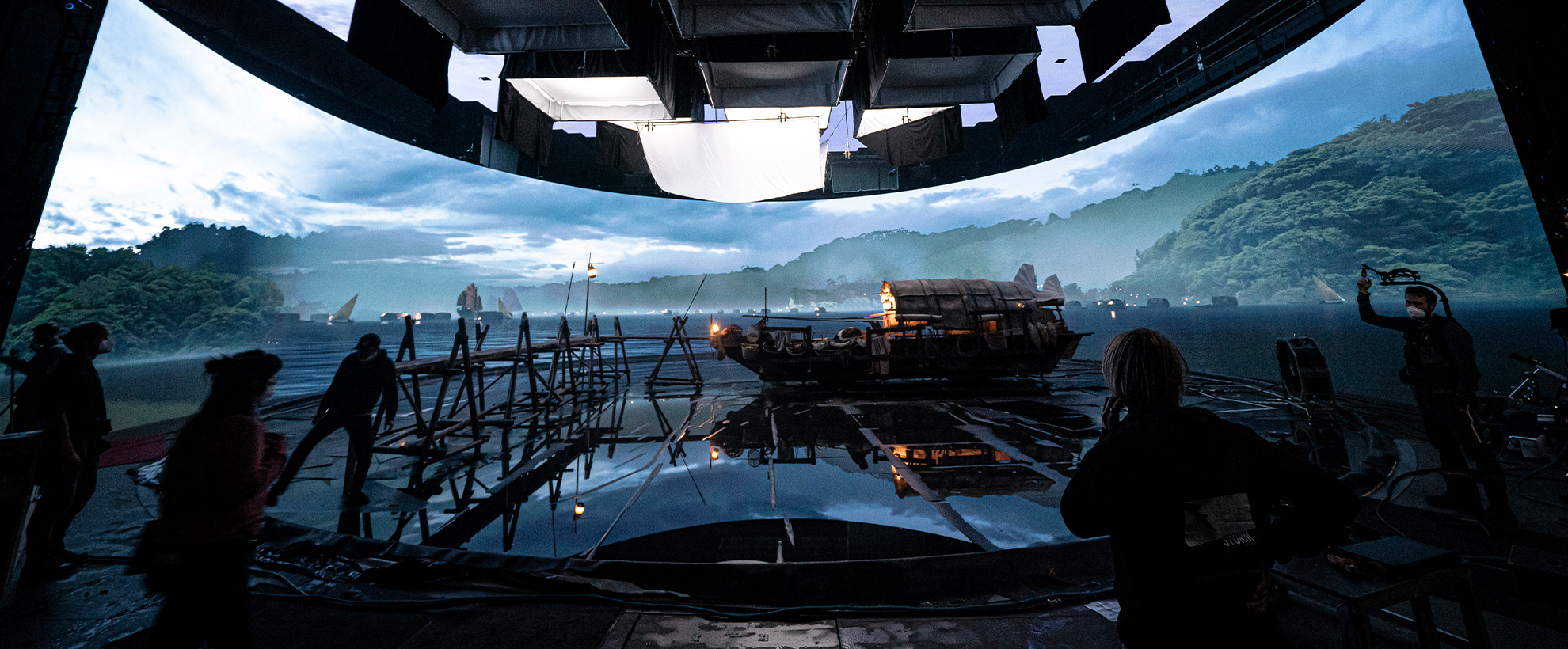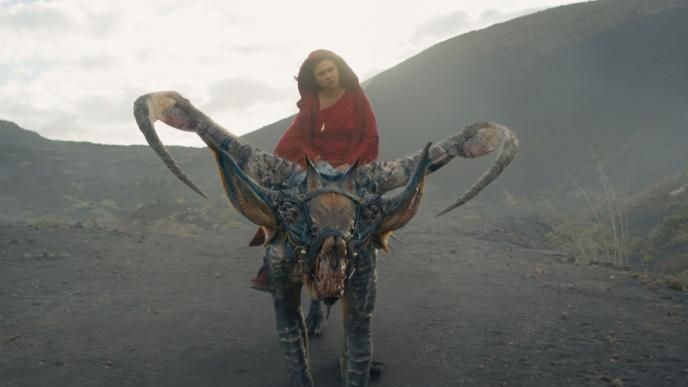
1899 Virtual Production
Framestore served as a ‘beginning to end’ creative partner on Netflix’s 1899, the supernatural mystery series from the creators of DARK - Jantje Friese and Baran bo Odar.
The Oscar, Emmy and BAFTA-winning creative studio was involved at every stage of the creative process, beginning at concept and ending with final VFX and title design as it took in the talent of teams in London, Montreal, Vancouver and Mumbai.
Pivotal to the process was Framestore Pre-production Services (FPS), a multi-disciplinary team whose work spans concept art, previs, on-set VP supervision and the skillful creation of in-engine photoreal content.
Set-up
1899 was filmed on a purpose-built volume at Studio Babelsberg, which features a state-of-the-art rotating LED volume stage. Framestore played an instrumental role in designing and setting up the new volume. Led by Overall VFX supervisor Christian Kaestner, a team of 19 artists, technicians and producers were embedded on-site in Babelsberg. Their collective experience spanned film, TV, gaming, immersive entertainment and live event production, and core members of the team included On-set Supervisor Andrew Scrase; Virtual Production Supervisor Alyssa Mello; Volume Supervisor Jack Banks; Head of Virtual Art Department Freddy Salazar; Virtual Production Producer Manon Hartzuiker and VAD / VFX Producer Martina Chakarova.


"This was a hugely ambitious project," says Overall VFX Supervisor Christian Kaestner. “Key to its success was collaboration and being involved from such an early stage. This meant we could bring together a best-in-the-business team of experts to ensure the virtual production technology and infrastructure could perfectly complement every facet of production and bring Jantje and Bo’s distinct creative vision to life.”
The FPS team was involved in setting up the show’s virtual production infrastructure, from its ‘brain bar’ control centre through to the LED screens themselves. “Beyond being high-res, we also needed to make sure that the panels could contend with the rigours of a show that was set on water,” says Volume Supervisor Jack Banks. “It was also important to get as much out of our Unreal builds as possible, so we worked hand-in-glove with Epic Games and Nvidia to bring dual graphics card support online and this gave us a huge increase in frame rate.”

The shift from post- to pre-production
1899’s shoot methodology meant the vast majority of creative decisions and asset creation had to be locked in pre-production. “Getting ‘in at the ground floor’ on a project is always best from a VFX perspective but when it comes to ICVFX it’s part of the process rather than a nice-to-have," says Kaestner. “The process brings together the entire production team, and we were able to work hand-in-glove with DOP Nik Summerer and Production Designer Udo Kramer to guide composition, lighting and set design. All of these creative decisions had to be made early on so that the Virtual Art Department had time to build, test and calibrate what was shown on the LED wall."


Virtual scouting was a vital part of the planning process, with the team previewing a VR iteration of the set in order to better collaborate on the production design and shot coordination. “Being able to scout the set and plan out the scenes with Jantje, Bo and Nik before we even had a stage was incredibly helpful,” says Kaestner. “It allowed us to determine the right camera angles based on the script, preview camera coverage for the set and see what we could do in the volume and what the methodology’s constraints might be.” This work also informed the show’s more heavy duty VFX elements, such as the imposing external environments. “Once we’d established the mood boards for the individual scenes with Bo, the virtual art department translated these into high resolution HDR images, which could be used as part of the crucial prelighting stage,” explains Kaestner. “Everything had to be prepped and set up as close to the final image prior to the shoot, in order to use the shooting day efficiently.”
Similarly, Framestore worked closely with Udo Kramer and his production design team to define the look and feel of the show, from the decks, dining room and engine room of the Kerberos to external locations in Hong Kong, Poland, Spain and Scotland, as well as the futuristic landscape. “The more hard work you do in pre-production the better the result,” explains On-set Supervisor Andy Scrase. “This goes hand in hand with having enough prep time, so getting set up early and being able to test on the stage was vital. This also allowed other departments to input into the process. For example, the set dressers were able to advise on layout so there was continuity between the practical and virtual sets. All of these relationships were vital when it came to developing convincing in-camera virtual production shots. For example, Udo was able to create set design components that allowed us to hide the ‘seam’ going from the physical set to the virtual one. There was a continual feedback loop involving all Bo, Jantje, Nik and Udo, especially during pre light - an essential step in the process that allowed us to bring practical and virtual together before shooting.”

One team who were instrumental in this were the London-based Virtual Art Department, led by Freddy Salazar. “The VAD started building our digital environments several months in advance,” says Scrase. “When shooting started, our team from Framestore made sure our content played as it should on the wall and that it tracked correctly with cameras on set.”
As part of the planning and design process, Framestore participated in the virtual scouting, previewing a VR simulation of the set to collaborate on the production design and shot coordination. ‘The virtual scouting we conducted with the showrunners and DOP was invaluable,' says Kaestner. The opportunity to scout the set and plan out the scenes before we had a stage not only helped us understand what needed to be done but also allowed us to advise the DOP and directors early on what shots were needed. We were also able to determine the right camera angle based on the script, previewing camera coverage for the set and seeing what we could do in the Volume and the limitations outside the Volume.
Leveraging the production value of VP
1899’s dynamic LED backdrops were rendered in Unreal Engine in real-time, replicating the physical camera moves to simulate a realistic background and environment. The entire process was captured in-camera, with effects added in real time, thus reducing post-production time and the need for green screens. 1899’s set had a large curved LED wall which created an immersive environment and generated a great deal of emissive, interactive lighting. ‘One of the biggest advantages was the lighting and environmental consistency that helps create realistic and dynamic imagery,” says Kaestner. “The ambient light from the LED screens means that correct, consistent light is created automatically. For an episodic project where most of the scenes take place on a ship, we were able to go back to the lighting and weather conditions, every day for six months in a row, and that was pretty unique - not to mention highly convenient.” The stage’s unique rotating stage also made for certain logistical benefits. “Being able to rotate the physical set 360 degrees and shoot in any direction saves an incredible amount of time,” notes Scrase. “It removes the need to rebuild sets overnight just to shoot shots in the opposite direction.

Ultimately, the use of these techniques reduced the number of shots that required post VFX work because the set blended so seamlessly with the virtual backdrop. And while planning in pre-production is key to success, Kaestner is keen to mention that, with adaptable technology, on-the-fly iteration and experimentation are possible without compromising the production process or budget. “One of the big advantages of virtual production is that you can start editing as soon as you’re done shooting,” says Kaestner.

While some replacement work will likely be necessary here and there, you are nevertheless able to see everything from your virtual production footage and this is a huge, huge benefit.


Optimising VP shots in post
The benefits of having Framestore as a pre- to post-production collaborator quickly became apparent as 1899 shifted from volume shoot into post. This was most notable with the show’s exterior shots where ocean replacement work was necessary. “Adopting virtual production methodology doesn’t mean you always get everything in camera,” explains Kaestner. “When it came to the establishing shots and ocean work, the VFX teams benefitted from the level of planning that went into the ICVX shots, since we were able to keep the set and the sky while focusing on creating perfect ocean replacements.” Similarly, because one of the show’s main CG assets, the Kerberos, was needed in pre-production, the VFX teams in Montreal and Vancouver were able to ingest the asset as the basis for their own work.
1899 was a unique project that drew on the skills of a supremely talented team capable of accommodating everything necessary to bring the showrunners’ creative vision to life.
Watch 1899 now streaming on Netflix.


